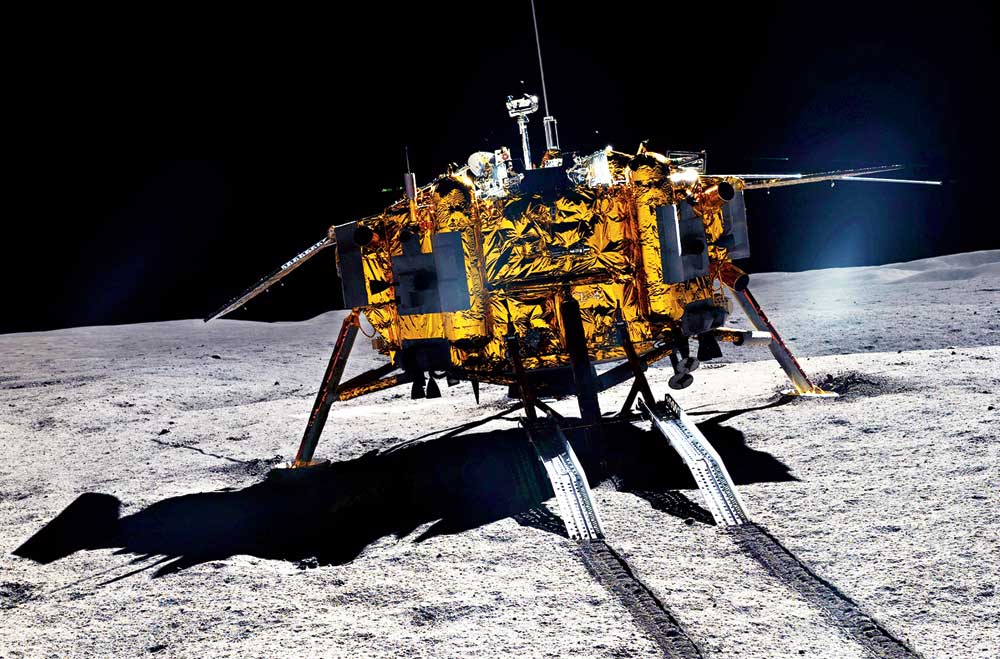China’s robotic Chang’e-4 spacecraft did something last year that had never been done before: it landed on the moon’s far side, and Yutu-2, a small rover it was carrying, began trundling through a crater there. One of the rover’s instruments, a ground-penetrating radar, is now revealing what lies beneath.
In a paper published in the journal Science Advances, a team of Chinese and Italian researchers showed that the top layer of the lunar soil on that part of the moon is considerably thicker than some expected — about 130 feet of what scientists call regolith.
“It’s a fine, dusty, sandy environment,” said Elena Pettinelli, a professor of mathematics and physics at Roma Tre University, Italy, who was one of the authors of the paper.
Based on what Nasa astronauts observed during the Apollo moon landings, other scientists said they would have expected one-quarter as much soil.
“That’s a lot of regolith,” said David A. Kring, a senior scientist at the Lunar and Planetary Institute in Houston, US, who is not involved with the Chinese moon mission. “That’s food for thought.”
Chang’e-4 landed just over a year ago inside Von Karman crater, a 110-mile-wide depression, and continues to explore an area that has not been seen up close before.
The radar technology aboard the rover is widely used on Earth to reveal buried structures, and it has been deployed on spacecraft that orbit Mars. But it has rarely been used on the surface of other worlds.
Yutu-2’s predecessor, which landed on the moon in 2013, carried an identical instrument. Three rovers scheduled to be launched to Mars in July, one by Nasa, one by a collaboration between Russia and the European Space Agency, and one by China, all have similar radar instruments.
Kring said he had worked on proposals to Nasa for using ground-penetrating radar on future missions to the moon, both robotic and crewed. The Chinese mission’s findings might show the technology’s utility, especially to find ice deposits beneath the lunar surface that could help make possible extended stays on the moon by humans.
“We think it would be a very useful tool for prospecting for subsurface ice deposits in the polar regions,” Kring said, adding that seeing the tool in use on the lunar surface “gives us more confidence that the method we had devised will work”. Although Von Karman crater lies within what is known as the South Pole-Aitken basin, an ancient 1,100-mile-wide impact crater, it is too far north for there to be ice in the soil.
The radar waves passed through the top 40 feet or so almost effortlessly, indicating a porous granular material. Below that, there were boulders, perhaps a couple of feet to a couple of yards in size. A third slice of soil, even lower, appeared to consist of alternating layers of fine and coarse particles but without any boulders.

The rover Yutu-2 Source: NYTNS
One surprise was that the researchers saw no signs of the radar bouncing off basalt — solidified lava — that would have pooled at the bottom of a crater as rocks melted by a meteor impact cooled. Yutu-2’s radar signals would have bounced off that rock if the rover had visited Von Karman crater soon after it formed.
But several billion years later, the basalt surface has been buried by regolith that was subsequently tossed up by later impacts. The top layer of fine particles may have also once contained boulders, but those may have been broken apart in eons of subsequent cosmic pummelling.
“It’s an old area,” Pettinelli said.
On Earth, very little of the surface is shaped by asteroid impacts. On the moon, the effects of space rock strikes can be seen almost everywhere.
“We oftentimes say that impact cratering is the dominant geologic process on the moon and elsewhere in the solar system, for that matter. And here is a classic example that illustrates that,” Kring said. “They’re nowhere close to the top of the lava flow.”
But the research also points to potential pitfalls of ground-penetrating radar data.
The Yutu instrument emits two frequencies of waves — a high-frequency band that Pettinelli and her colleagues analysed and a low-frequency band that penetrates deeper but does not provide as much detail and which they ignored in this paper, because they consider it unreliable.
Pettinelli said that as Yutu-2 gathers more data, it might be possible to remove the spurious reflections and pull out accurate findings about the deeper layers.
Last year, scientists reported that mineralogical analysis of materials at the surface inside Von Karman crater suggested that some of it might have been excavated from the moon’s mantle — the layer beneath its crust — by large impacts. Kring said the data was not conclusive, but the main purpose of the mission was to prove the technologies.
“I would not say these missions are producing extraordinary science,” he said. “But they are demonstrating a new-found capability. And they are on the science side, filling in some details, providing some details we didn’t have.”
The next two Chinese lunar missions aim to bring pieces of the moon back to Earth for closer study.










